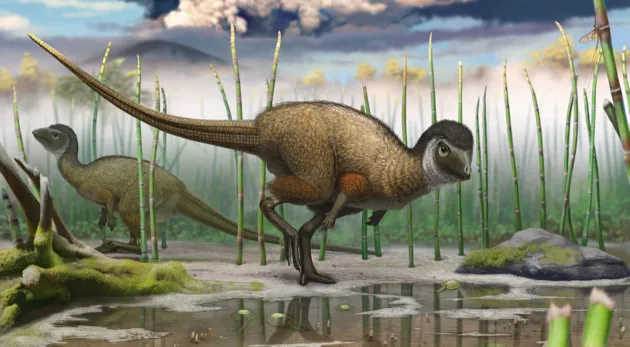When Jurassic Worldwas announced last year, it was revealed that none of the dinosaurs would have feathers. Now, director Colin Trevorrow could be regretting his decision: scientists have discovered that feathery dinosaurs were even more widespread than previously thought.
Palaeontologists in a Russian-Belgian team found evidence of feathers on a collection of 150 million-year-old fossils unearthed in Siberia. Up until now, all evidence of feathers had come from flesh-eating dinosaurs. These new fossils, on the other hand, belong to a plant-eating dinosaur, suggesting that all dinosaurs may have sported feathers at some point during their development.
In total, the scientists discovered six partial skulls and several hundred partial skeletons of a new dinosaur known as Kulindadromeus zabaikalicus. They found complex feathers on its arms and legs as well as signs of scaly skin on its tail and shins, plus short bristles on its head and back.
"I was really amazed when I saw this,” says Dr Pascal Godefroit from the Royal Belgian Institute of Natural History in Brussels. “We knew that some of the plant-eating dinosaurs had simple bristles, and we couldn’t be sure whether these were the same kinds of structures as bird and theropod feathers. Our new find clinches it: all dinosaurs had feathers, or at least the potential to sprout feathers."

So what was the purpose of these feathers? Research suggests that they didn’t initially come about for flight, but instead either played a more basic insulation role or served as a signal to attract mates. Only later did the feathers become adapted for flight, as seen on modern birds – the living descendants of the dinosaurs.
"Developmental experiments in modern chickens suggest that avian scales are aborted feathers, an idea that explains why birds have scaly legs,” says Prof Dhouailly at the Université Joseph Fourier in Grenoble, France. “The astonishing discovery is that the molecular mechanisms needed for this switch might have been so clearly related to the appearance of the first feathers in the earliest dinosaurs."
But don’t throw away those dinosaur books quite yet. If feathers were indeed widespread among dinosaurs, it’s possible that some lost their fluffy covering as adults. So the Tyrannosaurus rex may have been the lean, mean, featherless fighting machine that we’ve all come to know and love.
Follow Science Focus onTwitter,Facebook, Instagramand Flipboard
